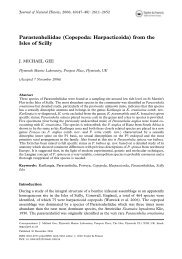An Updated Classification of the Recent Crustacea
An Updated Classification of the Recent Crustacea
An Updated Classification of the Recent Crustacea
You also want an ePaper? Increase the reach of your titles
YUMPU automatically turns print PDFs into web optimized ePapers that Google loves.
eventually led us to keep dromiids with <strong>the</strong> o<strong>the</strong>r<br />
‘‘primitive’’ brachyurans in our section Dromiacea,<br />
knowing that by so doing we are continuing to displease<br />
students <strong>of</strong> crab phylogeny who rely mostly<br />
on larval characters and that <strong>the</strong> current arrangement<br />
<strong>of</strong> primitive crabs is not completely in keeping<br />
with <strong>the</strong> molecular evidence in <strong>the</strong> Spears et al.<br />
(1992) study. A detailed discussion <strong>of</strong> <strong>the</strong> situation<br />
within <strong>the</strong> Dromiacea can be found in <strong>the</strong> review<br />
<strong>of</strong> <strong>the</strong> Dynomenidae by McLay (1999).<br />
Superfamily Dromioidea<br />
The families Dromiidae and Dynomenidae are still<br />
listed as valid families, although based on molecular<br />
data (Spears et al., 1992) and sperm morphology<br />
(Jamieson, 1994; Jamieson et al., 1995; Guinot<br />
et al., 1998), <strong>the</strong>ir monophyletic status has been<br />
questioned (but see McLay, 1991, 1999; Števčić,<br />
1995). Earlier classifications, some <strong>of</strong> which have<br />
included <strong>the</strong> Homolidae among <strong>the</strong> dromiacean<br />
families, are reviewed by Števčić (1995), Guinot<br />
and Richer de Forges (1995), and McLay (1999).<br />
Guinot et al. (1998) argue that <strong>the</strong> Dromioidea (referred<br />
to as Dromiacea in that paper, a lapsus calami,<br />
Guinot, pers. comm.), containing <strong>the</strong> three<br />
families Dromiidae, Dynomenidae, and Homolodromiidae,<br />
is a valid monophyletic superfamily, although<br />
<strong>the</strong>y note <strong>the</strong> differences separating <strong>the</strong><br />
homolodromiids. We have maintained <strong>the</strong> separate<br />
status <strong>of</strong> <strong>the</strong> homolodromiids (i.e., placing <strong>the</strong>m in<br />
<strong>the</strong>ir own superfamily Homolodromioidea; see below)<br />
in light <strong>of</strong> <strong>the</strong> many morphological features <strong>of</strong><br />
adults that seem to separate <strong>the</strong>m from <strong>the</strong> dromiids<br />
and dynomenids. In doing so, we follow Guinot<br />
(1995), even though Guinot and Bouchard (1998)<br />
have reverted to treating all three <strong>of</strong> <strong>the</strong>se families<br />
in one superfamily (<strong>the</strong>ir Dromiacea). The families<br />
were reviewed recently by McLay (1991, Dromiidae;<br />
1999, Dynomenidae) with special regard to<br />
<strong>the</strong>ir Indo-Pacific members.<br />
Superfamily Homolodromioidea<br />
Separate superfamily status for <strong>the</strong> Homolodromiidae<br />
appears warranted on <strong>the</strong> basis <strong>of</strong> larval and<br />
adult morphology (see Martin, 1991; Guinot,<br />
1995). Števčić (1998) considers <strong>the</strong> homolodromiids<br />
<strong>the</strong> most primitive extant family <strong>of</strong> brachyuran<br />
crabs. The date <strong>of</strong> Alcock’s establishment <strong>of</strong> <strong>the</strong><br />
Homolodromiidae has been changed from 1899 to<br />
1900 following <strong>the</strong> revision by Guinot (1995).<br />
Superfamily Homoloidea<br />
The alliance <strong>of</strong> homolids with dromiids has been<br />
supported by ultrastructural characters <strong>of</strong> <strong>the</strong><br />
sperm (Guinot et al., 1994; see also <strong>the</strong> extensive<br />
review by Guinot and Richer de Forges, 1995). The<br />
family Poupiniidae was added by Guinot (1991).<br />
SECTION EUBRACHYURA, SUBSECTION<br />
RANINOIDA<br />
Superfamily Raninoidea<br />
Within <strong>the</strong> Raninoidea, <strong>the</strong> subfamily Symethinae<br />
(monogeneric; Symethis Goeke) was elevated to<br />
family level by Tucker (1998), as had been suggested<br />
earlier by Guinot (1993). However, Tucker<br />
did not agree with <strong>the</strong> removal <strong>of</strong> <strong>the</strong> subfamily<br />
Cyrtorhininae from <strong>the</strong> Raninidae, which had been<br />
suggested as a possibility by Guinot (1993).<br />
Superfamily Cyclodorippoidea<br />
The superfamily Tymoloidea has been removed and<br />
in its place is <strong>the</strong> superfamily Cyclodorippoidea, as<br />
<strong>the</strong> family name Cyclodorippidae Ortmann has seniority<br />
over Tymolidae Alcock, according to Guinot<br />
(pers. comm.) and Tavares (1991, 1993). Tavares<br />
(1998) also established a new family, <strong>the</strong> Phyllotymolinidae,<br />
within <strong>the</strong> Cyclodorippoidea. Guinot<br />
and Bouchard (1998) continue to recognize <strong>the</strong> superfamily<br />
Cyclodorippoidea (as did Tavares, 1991,<br />
1993, 1998), stating that this was done ‘‘for convenience’’<br />
while at <strong>the</strong> same time cautioning against<br />
possible paraphyly in <strong>the</strong> assemblage.<br />
Placement <strong>of</strong> this superfamily with <strong>the</strong> raninoids<br />
in <strong>the</strong> Raninoida is possibly a mistake; molecular<br />
data seem to indicate a placement somewhere between<br />
<strong>the</strong> raninids and <strong>the</strong> higher eubrachyurans<br />
(T. Spears, pers. comm.).<br />
SECTION EUBRACHYURA, SUBSECTION<br />
HETEROTREMATA<br />
Superfamily Dorippoidea<br />
The family Orithyiidae Dana has been transferred<br />
to this superfamily based on <strong>the</strong> suggestion <strong>of</strong> Bellwood<br />
(1996, 1998; see below).<br />
Superfamilies Calappoidea and Leucosioidea<br />
The monophyly <strong>of</strong> <strong>the</strong> family Calappidae and its<br />
constituent subfamilies has been questioned recently.<br />
Bellwood (1996, 1998) has recommended that<br />
only <strong>the</strong> families Calappidae and Hepatidae be retained<br />
in <strong>the</strong> superfamily Calappoidea, with <strong>the</strong><br />
Matutidae joining <strong>the</strong> leucosiids in <strong>the</strong> Leucosioidea<br />
and with <strong>the</strong> Orithyiidae transferred to <strong>the</strong> dorippoids.<br />
To some extent, <strong>the</strong>se changes reflect earlier<br />
suggestions based on larval (Rice, 1980) and<br />
adult (Guinot, 1978; Seridji, 1993) morphology,<br />
and <strong>the</strong>re is at least some fossil support for this<br />
arrangement as well (Feldmann and Hopkins,<br />
1999; Schweitzer and Feldmann, 2000). Števčić<br />
(1983) had earlier suggested recognition <strong>of</strong> <strong>the</strong> Matutidae<br />
and Orithyidae and <strong>the</strong>ir separation from<br />
o<strong>the</strong>r Calappidae as well. We have followed Bellwood’s<br />
(1996) recommendations while at <strong>the</strong> same<br />
time not agreeing with her that <strong>the</strong> Oxystomata be<br />
retained. Bellwood’s rearrangement <strong>of</strong> <strong>the</strong> calappids<br />
is not supported by recent molecular data (S.<br />
Boyce, unpublished).<br />
Contributions in Science, Number 39 Rationale 51











